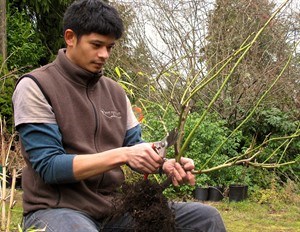
In this Feb. 12, 2014 photo, Rizanino (Riz) Reyes, a horticulturist, gives a rose bush some last-minute pruning before putting it in the ground. Avoid plants that need to be pruned for anything beyond minor cosmetic touches. (AP Photo/Dean Fosdick)
February 24, 2014 - 10:34 AM
Garden centres, with their vast collections of plant colours, sizes and shapes, can be intimidating to inexperienced buyers. But you can become a discerning purchaser with a little homework and by quizzing the sales people as you shop.
"Usually, when shopping, I go early before the crowds and also before the staff are worn out," said Jack McKinnon, a garden coach from the San Francisco Bay area. "I like asking questions like, 'What are you getting in next?' 'What is new?' and 'What is the most popular now?' If it is early (in the season), you may learn a lot that puts you ahead of the masses in designs and trends."
The most important factor in plant shopping, however, is the health of the plant, McKinnon said.
"As one nurseryman I trust says: 'Don't accept ugly plants.' And he doesn't give refunds."
How can you tell if a plant is diseased, pest-ridden or beyond its prime?
"Look for any unusual brown, black or grey spotting on the foliage," said Rizanino (Riz) Reyes, a landscape designer and owner of RHR Horticulture in Shoreline, Wash., a Seattle suburb.
"Any dead sections that are beyond just grooming to make it look good should be avoided," he said. Also avoid plants "that may be unusually red or sickly yellow looking."
It's a good idea to check plant roots at the nursery. It's risky to buy plants that are root-bound, too wet or too dry, although that may mean removing them from the pot to examine them.
"If you politely ask a garden centre staff member, any reputable retail centre should stand by their product and allow you to do it, or they may do it for you," Reyes said.
Other plant-buying-like-a-pro tips:
— Shop by price and shop the sales. Find out when new plants are usually delivered and displayed. "Try to have a relationship with the nursery owner or staff," McKinnon said.
— Bare-root, container grown, or balled and burlapped? "Bare-root plats have not had a chance to get root-bound in a pot, and you can see what you're buying," McKinnon said. "Both are definite advantages."
— Work from a plan. "I recommend having a general list so you avoid too many impulse buys on plants that may not end up getting planted or worse, get forgotten," Reyes said.
— Annuals vs. perennials: "Perennials come back and can look great the year-'round," Reyes said. "Annuals provide traffic-stopping impact and remarkable colour. You save and have the most incredible garden by integrating both."
— Buying tropicals and houseplants: "Take care in transporting these from the store to your vehicle as some may be very sensitive to the cold," Reyes said. "Plant them right away or keep them cool but not frozen. Keep them watered and moist."
— Choosing bulbs, corms, tubers and rhizomes: "Look for plump, firm bulbs," Reyes said. "Usually, the bigger the better. Hardy bulbs like lilies are ready to plant as soon as possible. For dahlias and other tender bulbs, wait until after frost to plant or pot them up and start indoors."
___
Online:
For more about buying healthy plants, see suggestions from Colorado State University Cooperative Extension: http://www.colostate.edu/Depts/CoopExt/4DMG/Garden/choosing.htm
You can contact Dean Fosdick at deanfosdick@netscape.net
News from © The Associated Press, 2014